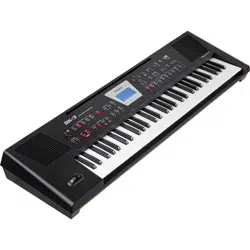Loading ...
Loading ...
Loading ...

Menu options
54
changes on any sequencer (software) you use. Changes you
don’t “freeze” are nevertheless stored when you save the edited
rhythm/song le—but only the BK-3 can read them.
The following parameters are available:
Reverb Type
This parameter allows you to specify what kind of reverb eect you
need. The available reverb types are:
Setting Meaning
Original
Original This setting means that the song uses its own
(programmed) reverb settings.
Room1,
Room2,
Room3
These types simulate the reverb characteristics of a
room. The higher the number (1, 2 or 3), the bigger the
“room” becomes.
Hall1,
Hall2
These types simulate the reverb of a small (1) or large
(2) concert hall and thus sound much “bigger” than the
Room types above.
Plate This algorithm simulates the acoustics of a concert hall.
Delay
A delay eect (no reverb). Works a lot like an echo
eect and thus repeats the sounds
Pan Delay
This is a stereo version of the above delay eect. It
creates repetitions that alternate between the left and
right channels.
Chorus Type
Chorus broadens the spatial image of the sound and creates a
stereo impression. You can choose from 8 types of chorus.
Setting Meaning
Original The song uses its own (programmed) chorus settings.
Chorus
1~4
These are conventional chorus eects that add
spaciousness and depth to the sound.
Fbk Chorus
This is a chorus with a anger-like eect and a soft
sound.
Flanger
This is an eect that sounds somewhat like a jet
airplane taking o and landing
ShortDly
This is a full-edged delay eect that can be used
instead of a chorus or anger. As you will see, there are
a lot of parameters you can program
ShortDlyFb This is a short delay with many repeats
Reverb Level & Chorus Level
These parameters allow you to modify the output level of the
Reverb (or Chorus) processor.
Rhythm Volume/Song Volume
This parameter allows you to set the overall volume of the selected
rhythm or song if you think it is too loud/soft.
Rhythm Tempo/Song Tempo
Allows you to change the rhythm’s or song’s tempo (q= 20~250).
Key
This parameter allows you to transpose all song parts (except the
drums) up to 12 semitones (1 octave) up or down. This value is
written to the song data and used every time you play back this
song.
NOTE
This parameter is not available for rhythms.
Undo Changes
Select this entry to cancel all “Rhythm/SMF Makeup Tools” settings
you have made and to revert to the previously saved version.
Instrument
To edit the Instrument parameters, use [MENU] button
“Makeup Tools” “Instrument”.
The display now shows all instruments used by the selected
rhythm or SMF song.
1. Use the [UP] or [DOWN] button to select the instrument
you want to change, then press the [ENTER] button.
The display changes to:
The [MENU] button’s indicator ashes.
2. Press the [MENU] button to jump to the location where
the instrument is used.
Playback starts automatically from that point.
3. Use the [UP] or [DOWN] button to select the parameter
you wish to edit.
4. Use the [INC] or [DEC] button change the parameter.
5. If you are satised with your changes and wish to
preserve them, save your rhythm/ song to the USB
memory. See “Saving Your New Rhythm or Song (SMF)
Version in USB Memory” (p. 57).
MEMO
If you select a Drum Set in step (1) above, the parameter list
looks slightly dierent than for instruments that do not use a
Drum Set. “Drum Sets” are special “Tones” that assign dierent
sounds to most keys/note numbers, allowing you (and the BK-3)
to play realistic drum and percussion parts.
NOTE
The changes you make using the procedure described above
can be “burned” into the rhythm/song le using the “Freeze
Data” (p. 57). Doing so will allow you to hear those changes
on any sequencer (software) you use. Changes you don’t “freeze”
are nevertheless stored when you save the edited rhythm/song
le—but only the BK-3 can read them.
Icon legend
The following icons refer to parameters that are respectively
available for:
T Tones of regular instruments only
D Drum Sets only
The following parameters are available:
Tone (T), Drum (D )
Allows you to select a dierent Tone within the active Tone family.
Loading ...
Loading ...
Loading ...
